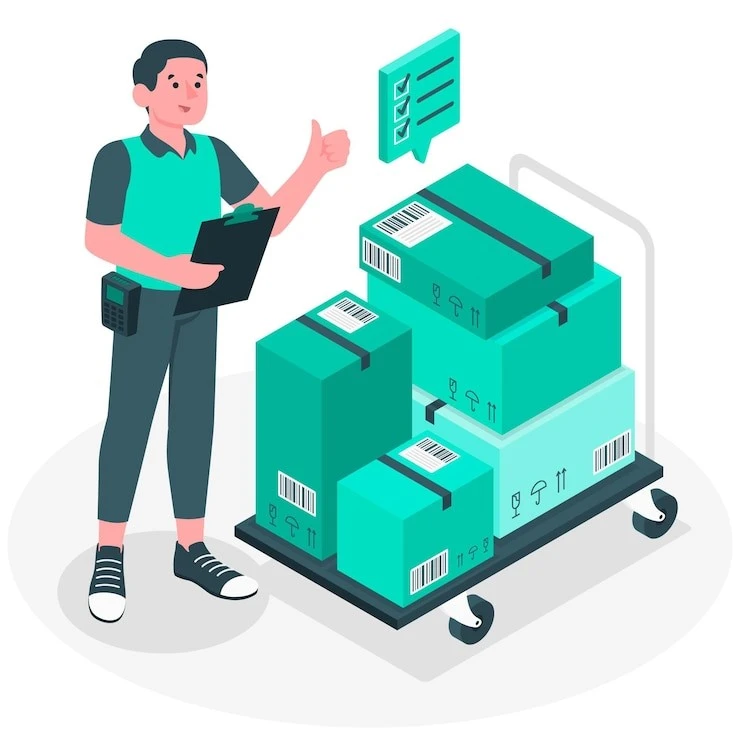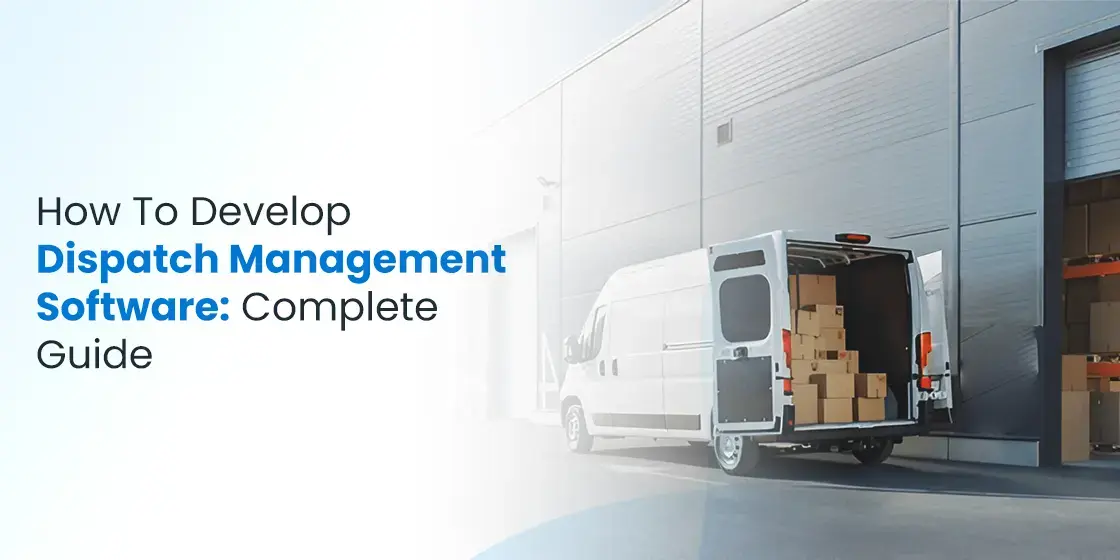Table of Content
Discover What Goes Into Developing Robust Dispatch Management Software in 2025
The logistics and transportation industry is experiencing a digital revolution, and dispatch management software sits at the heart of this transformation. As businesses struggle to meet rising customer expectations for real-time tracking, optimized routes, and seamless communication, the demand for sophisticated dispatch solutions has skyrocketed.
The global dispatch software market is expected to reach $5.3 billion by 2032, with a robust CAGR of 10%, making this an opportune time to understand how to develop dispatch management software. Knowing how to develop dispatch management software effectively requires more than just technical expertise. It demands a deep understanding of operational workflows, user pain points, and industry-specific challenges.
Whether you’re a business looking to create custom dispatch software or a developer seeking to enter this lucrative market, discover how professional enterprise software development services unlock significant competitive advantages. The right approach combines cutting-edge technology with practical functionality, ensuring your solution meets both current needs and future growth requirements.
Understanding Dispatch Management Software Fundamentals
Dispatch management software is a comprehensive digital tool that automates the scheduling, assignment, and tracking of tasks and resources for field service operations. At its core, this technology serves as the central nervous system for businesses that rely on mobile workforces, whether they’re delivering packages, providing technical services, or managing emergency responses. The software coordinates between dispatchers, field workers, and customers to optimize operations and improve service delivery.
The fundamental purpose of learning how to develop dispatch management software lies in solving operational inefficiencies that plague many industries. Traditional manual dispatching methods often result in miscommunication, suboptimal routing, and poor resource allocation. Modern dispatch software addresses these challenges by providing real-time visibility, automated scheduling capabilities, and data-driven insights that enable better decision-making across all levels of operation.
Understanding the scope of dispatch management is crucial for successful development. These systems, along with logistics software management, must handle multiple data streams simultaneously, including vehicle locations, driver availability, customer requirements, and external factors like traffic conditions. The software needs to process this information instantly and provide actionable recommendations while maintaining user-friendly interfaces for operators with varying technical expertise.
Essential Features for Modern Dispatch Software

Real-time tracking and GPS integration form the backbone of any effective dispatch management system. This functionality allows dispatchers to monitor vehicle locations, track delivery progress, and provide accurate ETAs to customers. When developing dispatch management software, implementing robust GPS tracking ensures transparency and enables proactive problem-solving when unexpected delays occur. Advanced systems also incorporate geofencing capabilities to automate notifications when vehicles enter or exit specific zones.
Automated scheduling and route optimization represent critical components that distinguish professional-grade dispatch software from basic tracking tools. These features use complex algorithms to assign jobs based on factors like technician skills, location proximity, equipment requirements, and customer preferences. The system should automatically generate optimized routes that minimize travel time and fuel consumption while maximizing the number of completed jobs per day.
Communication tools and customer notifications are equally essential when considering how to develop dispatch management software that truly serves all stakeholders. The platform should facilitate seamless communication between dispatchers, field workers, and customers through multiple channels including SMS, email, and in-app messaging. Automated customer notifications about technician arrival times, job progress updates, and completion confirmations significantly improve customer satisfaction and reduce support inquiries.
Fuel innovation by leveraging bespoke software solutions. Get in touch with our team of experts to build cutting-edge software products.
Get a QuoteTechnology Stack Selection for Dispatch Software
Frontend technologies play a crucial role in creating intuitive user interfaces for dispatch management software. React, Angular, or Vue.js are popular choices for building responsive web applications that work seamlessly across desktop and mobile devices. These frameworks enable developers to create dynamic dashboards that display real-time information effectively. For mobile applications, React Native or Flutter provide excellent cross-platform development capabilities, ensuring consistent user experiences across iOS and Android devices.
Backend development requires robust technologies capable of handling high-volume data processing and real-time communications. Node.js with Express.js offers excellent performance for real-time applications, while Python with Django or Flask provides strong capabilities for data analysis and machine learning integration. Java with Spring Boot remains a solid choice for enterprise-level applications requiring high scalability and security. The selected backend technology should support WebSocket connections for real-time updates and RESTful APIs for seamless integration with external services.
Database selection significantly impacts the performance and scalability of dispatch management software. PostgreSQL offers excellent support for geospatial data and complex queries essential for route optimization. MongoDB provides flexibility for handling diverse data types and rapid development cycles. For real-time tracking features, Redis serves as an excellent in-memory database for caching frequently accessed data. When planning how to develop dispatch management software, consider implementing a hybrid approach using multiple database technologies to optimize different aspects of the system.
Dispatch App Development Methodology – What Elements Go Into the Process?
The initial phase of learning how to develop dispatch management software involves comprehensive requirements gathering and system design. This process begins with stakeholder interviews to understand specific business needs, operational workflows, and user expectations.
Create detailed user personas for dispatchers, field workers, and customers to guide feature prioritization and interface design decisions. Document functional requirements clearly, including integration needs with existing systems like CRM, ERP, or accounting software.
Agile development methodology proves most effective for dispatch software projects due to their complexity and evolving requirements. Break the development process into manageable sprints, each delivering specific functionality that can be tested and refined.
Start with core features like basic scheduling and tracking, then progressively add advanced capabilities like AI-powered route optimization and predictive analytics. This approach allows for early user feedback and reduces the risk of developing features that don’t meet actual needs.
Testing and quality assurance require special attention when developing dispatch management software due to the critical nature of logistics operations. Pay particular attention to testing real-time features under various load conditions and ensuring data accuracy in GPS tracking and route calculations. Let’s take a look at other elements of the process as well.
Integration Capabilities and Third-Party Services

GPS and mapping services integration forms the foundation of effective dispatch management software. Google Maps API, Mapbox, or HERE Technologies provide reliable mapping and routing capabilities essential for location-based features. These services offer real-time traffic data, geocoding, and route optimization APIs that significantly enhance the software’s functionality. When considering how to develop dispatch management software, ensure the chosen mapping service supports the geographic regions where the software will operate and provides adequate API quotas for expected usage volumes.
Fleet management systems integration enables comprehensive vehicle monitoring and maintenance tracking. Telematics providers like Geotab, Verizon Connect, or Samsara offer APIs that provide vehicle diagnostics, fuel consumption data, and driver behavior insights through IoT in transportation. Integrating these systems allows dispatch software to consider vehicle condition and driver performance when making assignment decisions. This integration also enables predictive maintenance capabilities that can prevent costly breakdowns and service disruptions.
Customer communication platforms and payment processing integrations streamline end-to-end service delivery. Communication APIs from Twilio or SendGrid enable automated SMS and email notifications, while payment processors like Stripe or Square facilitate seamless transaction processing. CRM integration with systems like Salesforce or HubSpot ensures customer data consistency across platforms. These integrations create a cohesive ecosystem that improves operational efficiency and customer experience simultaneously.
User Experience and Interface Design
Creating intuitive interfaces for different user types represents a critical aspect of successful dispatch software development. Dispatchers require comprehensive dashboards displaying real-time fleet status, job queues, and performance metrics in easily digestible formats. The interface should support drag-and-drop job assignment, quick filtering and searching capabilities, and customizable views that accommodate different operational preferences. Visual indicators for urgent jobs, overdue tasks, and system alerts help dispatchers prioritize their actions effectively.
Mobile interfaces for field workers must prioritize simplicity and offline functionality. These users often work in challenging environments with limited connectivity, so the mobile app should cache essential information and sync updates when connection becomes available. Large, touch-friendly buttons accommodate use with gloves, while voice-to-text capabilities enable hands-free data entry. GPS-based features should work seamlessly in the background without draining device batteries excessively.
Customer-facing interfaces require polished design and self-service capabilities that reduce support burden. Online portals should allow customers to schedule services, track job progress, and access service history easily. Real-time notifications about technician arrival times and job status updates keep customers informed without requiring phone calls. When learning how to develop dispatch management software, prioritize responsive design that works equally well on desktop computers and mobile devices, as customers increasingly expect multi-channel access to services.
Security and Compliance Considerations
Data security implementation requires multiple layers of protection to safeguard sensitive customer and operational information. Implement end-to-end encryption for all data transmissions, especially GPS coordinates and customer details. Use secure authentication methods including multi-factor authentication for administrative users and role-based access controls that limit data access based on job functions. Regular security audits and penetration testing help identify vulnerabilities before they can be exploited.
Privacy compliance becomes particularly important when developing dispatch management software that handles location data and personal information. GDPR compliance requires explicit consent for data collection, clear privacy policies, and the ability to delete customer data upon request. In the United States, various state regulations like CCPA impose additional requirements. Design data collection practices to minimize the amount of personal information stored while still providing necessary functionality.
Industry-specific compliance requirements vary significantly depending on the target market. Healthcare dispatch software must comply with HIPAA regulations, while financial services may require SOX compliance. Transportation companies often need DOT compliance features, and emergency services require specific certification standards. Understanding these requirements early in the development process prevents costly redesigns and ensures market acceptance. When planning how to develop dispatch management software, research applicable regulations thoroughly and build compliance features into the core architecture.
Advanced Features and AI Integration

Artificial intelligence and machine learning capabilities can significantly enhance dispatch software functionality. Predictive analytics can forecast demand patterns, helping businesses optimize staffing and inventory levels. Machine learning algorithms can analyze historical data to improve route optimization, considering factors like traffic patterns, weather conditions, and driver preferences. AI-powered chatbots can handle routine customer inquiries, freeing human agents to focus on complex issues, and is one of the most popular artificial intelligence use cases today.
IoT integration expands the software’s capabilities beyond basic scheduling and tracking. Connected sensors can monitor vehicle health, cargo conditions, and driver behavior in real-time. This data enables proactive maintenance scheduling, ensures cargo quality during transport, and supports driver safety programs. Smart city initiatives provide additional data sources like traffic light timing and parking availability that can further optimize routing decisions.
Automation features reduce manual workload and improve operational consistency. Automated job assignment based on predefined rules can handle routine scheduling decisions, while exception-based management highlights situations requiring human intervention. Automated customer communications keep all parties informed without dispatcher involvement. When considering how to develop dispatch management software with advanced features, focus on automating repetitive tasks while maintaining human oversight for complex decisions.
Development Costs and Budget Planning
Understanding the financial investment required for dispatch software development helps in realistic project planning. Basic dispatch management software typically costs between $50,000 to $150,000 to develop, depending on feature complexity and development team location. Moderate complexity systems with advanced features like AI-powered routing and extensive integrations can range from $150,000 to $400,000. Enterprise-level solutions with custom features and high scalability requirements often exceed $400,000 in development costs.
Several factors significantly influence development costs when learning how to develop dispatch management software. Geographic location of the development team affects hourly rates, with North American developers typically charging $80-150 per hour, while Eastern European teams may charge $30-70 per hour. Project complexity, including the number of integrations, custom features, and supported platforms, directly impacts development time and costs. Team composition also matters—senior developers cost more but often deliver higher quality code and faster development cycles.
Ongoing maintenance and operational costs require careful consideration in budget planning. Annual maintenance typically costs 15-25% of initial development investment, including bug fixes, security updates, and minor feature enhancements. Cloud hosting costs vary based on user volume and data storage requirements, potentially ranging from $500 to $5,000 monthly for mid-sized operations. Third-party service costs for mapping APIs, communication services, and integrations can add $1,000 to $10,000 monthly depending on usage volumes.
Testing and Quality Assurance
Comprehensive testing strategies ensure dispatch software reliability under real-world conditions. Unit testing validates individual components like route calculation algorithms and data processing functions. Integration testing verifies that different system components work together correctly, particularly important for real-time features and third-party integrations. Load testing simulates multiple concurrent users and high-frequency location updates to identify performance bottlenecks before deployment.
Field testing with actual users provides invaluable insights into usability and functionality gaps. Conduct pilot programs with friendly customers or internal teams such as those managing production planning software to test the software under realistic conditions. This testing phase often reveals edge cases and workflow issues that aren’t apparent in controlled environments. User feedback during pilot testing helps prioritize bug fixes and feature refinements before full deployment.
Performance monitoring and optimization require ongoing attention after initial deployment. Implement comprehensive logging and monitoring systems to track system performance, user behavior, and error patterns. Database query optimization becomes crucial as data volumes grow, particularly for location tracking and historical reporting features. When planning how to develop dispatch management software, design monitoring capabilities into the initial architecture rather than adding them retroactively.
Deployment and Launch Strategy

Cloud deployment strategies offer scalability and reliability advantages for dispatch management software. Amazon Web Services, Microsoft Azure, and Google Cloud Platform provide robust infrastructure with built-in redundancy and global availability. Container orchestration using Docker and Kubernetes enables easy scaling and deployment across multiple environments. Consider multi-region deployment for businesses operating across large geographic areas to minimize latency and improve user experience.
User training and onboarding programs ensure successful software adoption, adopting the concept of agility in supply chain and dispatch management. Create role-specific training materials for dispatchers, field workers, and administrative users. Video tutorials work well for visual learners, while hands-on training sessions help users practice with realistic scenarios. Establish clear escalation procedures for technical support and provide comprehensive documentation that users can reference independently.
Gradual rollout strategies minimize risk and allow for refinement based on user feedback. Start with a pilot group of users to identify any remaining issues before full deployment. Implement feature flags that allow gradual activation of new capabilities as users become comfortable with basic functionality. Monitor system performance and user adoption metrics closely during rollout to identify and address problems quickly.
Monetization and Business Models
Subscription-based models provide predictable revenue streams for dispatch software businesses. Offer tiered pricing based on the number of users, vehicles, or jobs processed monthly. This approach allows customers to start with basic functionality and upgrade as their needs grow. Include different feature sets at each tier to encourage upgrades while ensuring the base tier provides genuine value.
Custom development and consulting services can supplement software licensing revenue. Many businesses require specific integrations or customizations that go beyond standard software capabilities. Professional services for implementation, training, and ongoing support create additional revenue opportunities while deepening customer relationships. When considering how to develop dispatch management software as a business, balance standardized features with customization capabilities.
Marketplace and ecosystem strategies can expand revenue opportunities through partner integrations and third-party extensions. Create APIs that enable other software vendors to integrate with your platform, potentially earning revenue through transaction fees or revenue sharing. White-label solutions allow partners to resell your software under their brand, expanding market reach without direct sales efforts.
Future Trends and Scalability
Emerging technologies will continue shaping dispatch software development over the next several years. 5G networks will enable more sophisticated real-time applications with lower latency. Augmented reality could provide field workers with enhanced information about job sites and equipment. Blockchain technology might improve supply chain transparency and automated payments. When planning how to develop dispatch management software for long-term success, design architectures that can incorporate these emerging technologies.
Scalability planning should account for both technical and business growth requirements. Design database schemas that can handle increasing data volumes without performance degradation. Implement microservices architecture that allows individual components to scale independently based on demand. Consider global expansion requirements early in development to avoid costly architectural changes later.
Environmental and sustainability concerns are increasingly influencing dispatch software development. Features that optimize routes for fuel efficiency, support electric vehicle integration, and provide carbon footprint reporting are becoming competitive advantages. Sustainability metrics may become as important as traditional efficiency measures in evaluating dispatch software effectiveness.
Frequently Asked Questions
| What programming languages are best for developing dispatch management software? The best programming languages for dispatch management software development include JavaScript (Node.js) for real-time features, Python for data analysis and AI integration, and Java for enterprise-scale applications. JavaScript works particularly well for full-stack development, allowing consistent code across frontend and backend. Python excels at route optimization algorithms and machine learning features, while Java provides robust security and scalability for large enterprise deployments. |
| How long does it typically take to develop dispatch management software? Development timeline varies significantly based on complexity and features. Basic dispatch software with essential features typically takes 6-12 months to develop. Moderate complexity systems with advanced routing, integrations, and mobile apps require 12-18 months. Enterprise-level solutions with custom features, AI integration, and extensive third-party connections can take 18-36 months. These timelines assume experienced development teams and clear requirements from the start. |
| What are the most important integrations for dispatch management software? Critical integrations include GPS and mapping services (Google Maps, Mapbox), communication platforms (Twilio for SMS, email APIs), payment processors (Stripe, Square), and fleet management systems for vehicle tracking. CRM integration ensures customer data consistency, while accounting system integration streamlines billing processes. Weather services, traffic data providers, and telematics systems provide additional operational insights that improve dispatch decisions. |
| How much does it cost to develop custom dispatch management software? Custom dispatch management software development costs range from $50,000 for basic systems to over $400,000 for enterprise solutions. Factors affecting cost include feature complexity, number of integrations, development team location, and project timeline. Ongoing costs include maintenance (15-25% of development cost annually), cloud hosting ($500-5,000 monthly), and third-party service fees ($1,000-10,000 monthly) depending on usage volume and required integrations. |
| What security measures are essential for dispatch management software? Essential security measures include end-to-end encryption for all data transmission, multi-factor authentication for administrative users, and role-based access controls. Regular security audits, penetration testing, and compliance with relevant regulations (GDPR, HIPAA, etc.) are crucial. GPS location data requires special protection due to privacy concerns. Implement secure API authentication, regular security updates, and comprehensive logging to monitor for potential security breaches. |
Conclusion
Learning how to develop dispatch management software requires balancing technical complexity with practical usability across multiple user types and operational scenarios. Success depends on thorough planning, careful technology selection, and iterative development approaches that incorporate user feedback throughout the process. The growing market demand creates significant opportunities for well-executed dispatch software solutions.
The investment in dispatch management software development can yield substantial returns through improved operational efficiency, enhanced customer satisfaction, and competitive differentiation. However, success requires commitment to ongoing development, user support, and feature enhancement as market needs evolve. The complexity of these systems makes partnering with experienced development teams often more cost-effective than attempting in-house development.
As the logistics and field service industries continue digitalizing, dispatch management software will become increasingly sophisticated and essential for business success. Companies that invest in robust, scalable solutions now will be better positioned to capitalize on future opportunities and meet evolving customer expectations in an increasingly competitive marketplace.
Empower your digital initiatives with BariTechSol, a premier custom software development company. Our skilled team tailors cutting-edge solutions to your unique needs. Elevate your tech experience and stay ahead in the digital realm. Partner with BaritechSol and code the success of your next big idea.


